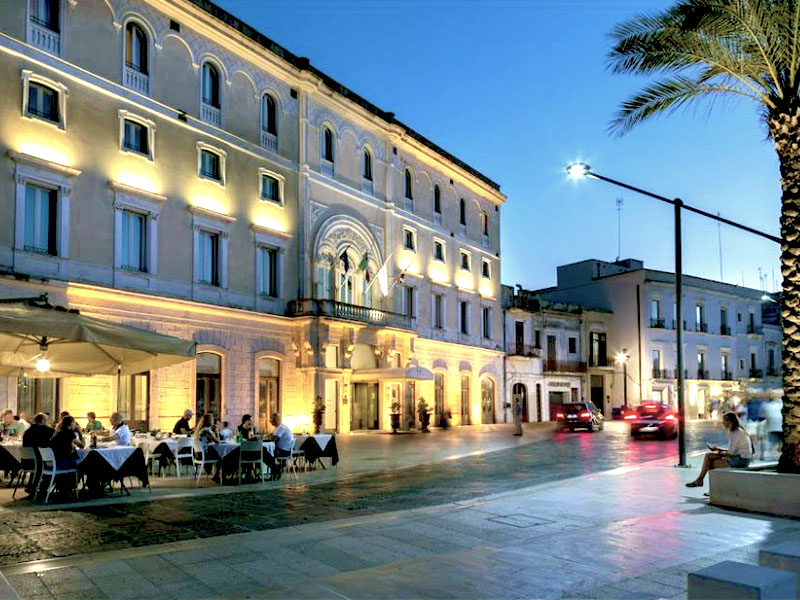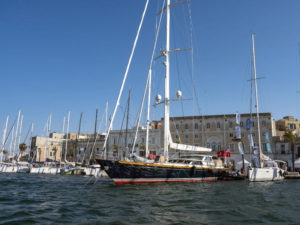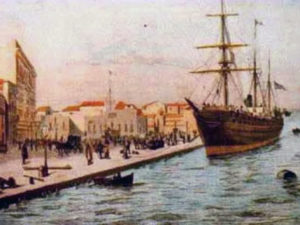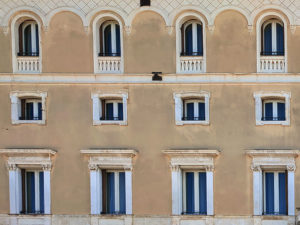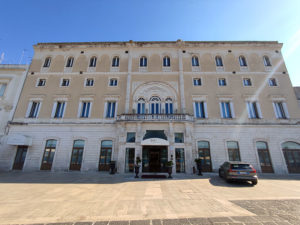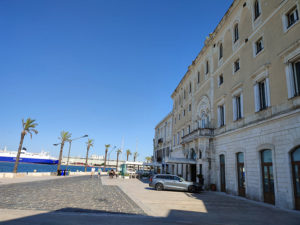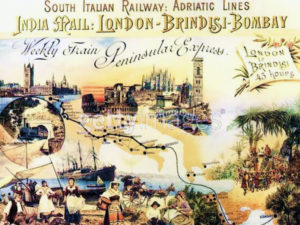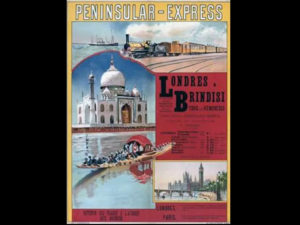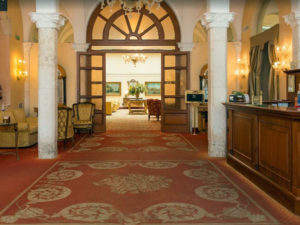La rotta tra Inghilterra e l’India
Grande Albergo Internazionale, XIX sec., già Great Eastern India Hotel
Il Grande Albergo Internazionale fu costruito nel 1869 dalla Società Italiana per le Strade Ferrate Meridionali, dapprima con il nome di Brindisi Hotel, poi Great Eastern India Hotel e International Hotel.
La sua costruzione si lega indissolubilmente all’apertura della rotta della Valigia delle Indie, il servizio di comunicazione veloce per posta e passeggeri tra l’Inghilterra e l’India. I treni che partivano da Londra arrivavano alla stazione marittima di Brindisi e da qui i piroscafi della Peninsular and Oriental Company assicuravano il collegamento diretto con Bombay e Calcutta, anche grazie alla recente apertura del Canale di Suez, nel 1859.
L’edificio architettonicamente richiama l’architettura veneziana, con la trifora centrale sopra il portone d’ingresso, elemento tipico dei palazzi lagunari, carattere sottolineato dalla presenza dell’acqua, affacciandosi l’albergo direttamente sul porto.
Il primo viaggio ufficiale della Valigia delle Indie avvenne il 25 ottobre del 1870: era il primo piroscafo, denominato “Delta”, della società inglese Peninsular and Oriental Steam Navigation Company con sede nel vicino Palazzo Montenegro, e salpava dal porto di Brindisi per Alessandria d’Egitto. Il percorso dal 1870 al 1914, fu quello di Londra-Calais-Brindisi, via terra; Brindisi-Suez-Bombay-Calcutta, via mare.

Brindisi fu proiettata nel circuito internazionale degli scambi commerciali, affollata da passeggeri, poeti e artisti come il greco Kavafis, il francese Charles Yriante, l’indiano Tagor, il Mahatma Gandhi, il poeta Rimbaud e Jules Verne, che alla città dedicò una tappa nel suo celebre Giro del mondo in 80 giorni, ma anche Marahaja indiani come Sayyaji Rao Gaekwad di Baroda, giunto da Bombay con il suo seguito di 23 persone, il celebre esploratore africano Henry Morton Stanley, che soggiornò con la sua signora di ritorno dall’Australia.
Dopo 44 anni circa, il collegamento della Valigia delle Indie da Brindisi fu definitivamente soppresso a causa dello scoppio della prima guerra mondiale, quando per Brindisi fu privilegiata una destinazione militare.
Ancora oggi nel cimitero di Brindisi c’è una piccola zona nei pressi dell’ingresso principale, dove sono le sepolture di chi, per malattia o disgrazia, morì durante il viaggio e qui venne sepolta nel corso di quel periodo.
Nel 1943, quando la città fu Capitale d’Italia, questa dimora storica sul porto ospitò per una ventina di giorni Re Vittorio Emanuele III e consorte, la Regina Margherita, da cui il toponimo del lungomare su cui sorge l’albergo.
Il Re e la Regina d’Italia soggiornarono qui dopo l’allontanamento da Roma, all’alba del 9 Settembre, insieme al Capo del Governo ed alcuni vertici militari, subito dopo l’Armistizio con le forze americane.
Note Bibliografiche:
– fondoambienteitaliano.it, sito istituzionale del FAI
– albergointernazionale.it
– brundarte.it
The route between England and India
The Great International Hotel, XIX century, already known as Great Eastern India Hotel
The Great International Hotel was built in 1869 by the Italian Society for the Southern Railways, firstly with the name of Brindisi Hotel, then Great Eastern India Hotel and, finally, International Hotel. Its construction is inextricably related to the opening of the route of “Valigia delle Indie”, the service of fast communication for mail and passengers between India and England. Trains leaving from London arrived in the Maritime Station of Brindisi, and from there the steamers of the Peninsular and Oriental Company assured the direct connection with Bombay and Calcutta, also thanks to the opening of the Suez Canal, in 1859.
The building recalls the venetian architecture, with the central trifora above the portal of entrance, a typical element of the lagoon buildings. This feature is underlined by the presence of the water, since the hotel overlooked directly to the harbor.
The first official travel of the Valigia delle Indie was on the 25th of October 1870: it was the first steamer, called “Delta”, of the English company Peninsular and Oriental Steam Navigation Company, headquartered in the near Montenegro Palace. It sailed from the port of Brindisi, directed to Alexandria of Egypt. The route was, between 1870 and 1914, the one passing from London-Calais-Brindisi, by land; and Brindisi-Suez-Bombay-Calcutta, by sea.
Brindisi entered in the international circuits of commercial trade, frequented by passengers, poets and artists like the Greek Kavafis, the French Charles Yriante, the Indian Tagor, Mahatma Gandhi, the poet Rimbaud, and Jules Verne, who dedicated to the city a leg of the journey in its famous work “Around the World in 80 Days. Also, the city was visited by Indian Marahaja like Sayyaji Rao Gaekwad di Baroda, came from Bombay with his entourage of 23 people; by the African explorer Henry Morton Stanley, who stayed in Brindisi with his wife when returning from Australia.
After roughly 44 years, the connection of the Valigia delle Indie from Brindisi was definitively suppressed because of the start of the First World War, when Brindisi was chosen as military destination. Still today, in the Cemetery of Brindisi, there is a little area near the main entrance, where there are buried people died during their travel because of sickness or for disgrace.
In 1943, when the city became Capital of Italy, this historic residence overlooking the port hosted the King Vittorio Emanuele III and his wife the Queen Elena. The King and the queen stayed here after their flee from Rome, at the down of the 9th of September, together with the Head of Government and some military leaders, in the aftermath of the armistice with the American forces.
Bibliographic notes:
– fondoambienteitaliano.it, sito istituzionale del FAI
– albergointernazionale.it
– brundarte.it

